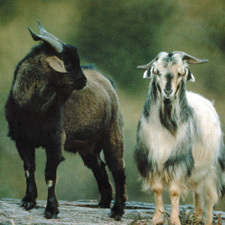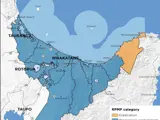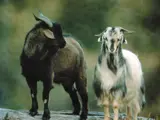 Feral goats
Feral goats
Common name: Feral goat
Botanical name: Capra hircus
Management programme: Eradication, Progressive Containment
Where did they originate from?
Feral goats were first introduced into New Zealand as a food source in the nineteenth century, by whalers and sealers. They were subsequently used to control weeds on land and to establish a commercial fibre (mohair) industry. Control began as early as 1915, with Government funded goat control beginning in 1924 to protect conservation values.
Why are they a pest?
- Goats eat native plants, trample large areas of vegetation.
- Goats are well adapted to a wide range of environments, favouring steep, rocky terrain and slip faces that many other animals cannot easily reach. This contributes to erosion and inhibits revegetation on steeper classes of land.
- In native forests, continued goat browsing of understory shrubs and regenerating trees alters forest structure; this also creates a more favourable habitat for other pests such as possums.
- Goats can also severely damage exotic forests by browsing young trees, and by stripping bark from older trees.
Where are they found?
- Goats can travel relatively large distances and invade a range of habitats. Goats are notorious for breaching fences and they have significantly increased their range from where they were initially released by European settlers.
- Areas most at risk from goats include introduced and native grasslands, scrub, and forest.
- Feral goats can be found through most of the Bay of Plenty region, with the highest infestations in the eastern Bay of Plenty.
What do they look like?
- Both male and female goats have horns and they be white, brown, or black, or any combination of these colours. Males are larger than females and have heavier forequarters, shaggier coats, larger horns and are bearded (some females may be bearded as adults).
- Goat tracks show two symmetrical cleaved hooves with pointed, slightly incurved tips, which are slightly more kidney shaped than sheep, pig or deer prints.
- Faecal pellets can be found singly or in groups and are smooth, an elongated oval shape, rounded at each end. They are normally slightly smaller than deer pellets.
- The call is a ‘meh’ rather than a ‘baa’ (sheep).
- Rutting males have a pungent smell.
What are the rules?
Under the Wild Animal Control Act 1977, a feral goat is any goat that is not:
(a) held behind effective fences or otherwise constrained; and
(b) identified in accordance with a recognised identification system (as described under the Animal Identification Act 1993).
Any feral goat that invades a property may be destroyed or otherwise disposed of by the landowner. Non-feral (tagged) goats that trespass may be dealt with under the Impounding Act 1955. For further information contact your local district council. All care should be taken to avoid such circumstances through responsible animal husbandry.
Feral goats are listed in the Bay of Plenty Regional Pest Management Plan as either “Eradication” or “Progressive containment” species, depending on their location. Please refer to the map below to identify which rules apply to your area.
Eradication
Eradication pests are present in the region but are limited in their size or extent of infestation. The eradication of these organisms is a feasible and cost-effective solution. The Bay of Plenty Regional Council is responsible for their control or eradication from the region. Action may be required from landowners or occupiers to support a control operation.
Progressive Containment
Progressive Containment species are pests which the Council aims to prevent from spreading, reduce the distribution, or eradicate within parts of the region over time. Landowners or occupiers are responsible for the control of Progressive Containment species on their property. Council may enforce the control of these pest species.
Note: Council will maintain control and management of feral goats. These pests are high risk but will not meet the eradication objective, and do not lend themselves to occupier control responsibilities.
How do you control them?
Shooting is the most effective goat control method. It is strongly recommended that only experienced hunters carry out goat control work as poor delivery could result in surviving animals dispersing and becoming very wary of hunters.
Sunny faces in areas of steep terrain and scrub (favoured goat habitat) can be effectively covered by helicopter, and aerial shooting is often a cost-effective control option alongside conventional ground control methods. Contact the Bay of Plenty Regional Council for advice on control operations.
Fencing is another option to exclude goats. The best goat proof fence is a deer netting fence that is well secured at ground level.
Read more on pest control guidelines and regulations
Management programme map
Images


